All things considered, ClickUp is the best software for building Gantt charts, and even has several Gantt-focused project management templates. ClickUp’s Gantt charts are available on all of its plans, including its Free Forever plan (but you’ll be limited to 60 uses per workspace).
On top of its easy-to-find Gantt view, you’ll find ClickUp’s additional features make managing projects much easier. You can brainstorm ideas on an online whiteboard, split up complex tasks into sub-tasks, and get a top-level view of a project’s progress with more than a dozen ClickUp views.
ClickUp is great, but it’s far from the only provider on the market. monday.com, for instance, is not only our top pick of project management tools, but has some great Gantt chart functionality on its later plans. As we’ll demonstrate over the course of this guide, there are several viable options out there.
How to Choose a Gantt Chart Provider
Here’s our two cents – it’s much better to go for an all-round great project management tool than to look for a Gantt chart provider specifically. Luckily, almost all project management software programs offer some sort of Gantt chart feature – and many of them are pretty similar.
Therefore, we’ve outlined a few things to consider when choosing the right Gantt chart provider:
- The price of the project management software
- Which pricing plan Gantt charts are available on
- Other features the project management software application has
- Whether Gantt charts is a plug-in/add-on for the software or an ‘out-the-box’ feature
- The extent to which populating the Gantt chart is automatic or manual
- What the Gantt chart looks like – aesthetics are important!
In this article, we’ll cover:
Best Gantt Chart Software
At Tech.co, we test all the products we review, and project management software is no different. Below, we’ve listed our top project management software providers, and you can see which ones provide Gantt charts – as well as whether they’re available on the provider’s free plans.
| Price from All prices listed as per user, per month (billed annually) | Gantt Chart | Gantt Chart on Free Plan? | Pros | Cons | Verdict | ||||
|---|---|---|---|---|---|---|---|---|---|
| GREAT VALUE | BEST OVERALL | BEST FOR SPREADSHEETS | |||||||
| | | | | | | Available as an add-on with Ganttify | | | |
| | | | | | | | | | |
|
|
|
|
|
|
|
|
|
|
|
|
|
|
|
|
|
|
|
|
| Powerful, feature-rich software suitable for teams of all sizes, with an impressive free tier for individuals, and a great value plans for teams | Incredibly easy to use, great for small businesses and our top-performing provider on test – and there’s a generous free trial period | A great tool for spreadsheet-natives, which can take your Excel-based task planning to the next level | A very capable yet pricey service with a huge number of useful integrations, plus a free tier option to try | A great user experience all round, with an easy-to-use automation builder and great budget tracking capabilities | A fairly-priced, stripped-down option, best for small teams who need a central location for basic task management | A very basic, relatively limited software that’s a lot simpler than its competitors | A great value piece of software that’s ideal for tech, software development, and engineering teams | A simple task-list-based project management platform with an acceptable free tier | A solid project management solution with an attractive free tier for small teams and a very affordable premium plan |

Pros
- 11+ ways to view project progress and data
- Useful “Chat” view for collaboration
- Team view for organizing tasks by team member
- Cheaper than monday.com and Wrike
- Agile project management features
- Vast number of features, even on cheap plans
Cons
- Customizability can be overwhelming to new users
- Not great at compiling project feedback
- Comparatively clunky automation builder
- Slow to load on our tests
- No 24/7 live support
- Fewer integrations than competitors
- Free plan available

- Unlimited: $7/user/month

- Business: $12/user/month

ClickUp overview
Here at Tech.co, ClickUp is one of our favorite project management tools. It’s easy to use – especially when you’re setting up. ClickUp only needs your project details once and after you’ve inputted your task list, you’ll be well on your way.
ClickUp is a real all-rounder. With some excellent task management tools, it’s more of a Work OS than the other options on this list, meaning that it’s a great solution for businesses looking to avoid juggling multiple different software providers. It would be great for a small design agency, for instance. The creative directors could use it to keep on top of different client briefs, while using ClickUp Chat to communicate instantly with remote freelancers, if required.
The only slight downside to ClickUp is that it doesn’t have dedicated budget management features, which providers like Teamwork have on their most expensive plans. But that’s one very minor downside to an otherwise excellent program you’re guaranteed to find useful.
ClickUp Gantt chart
Although Gantt charts are available on ClickUp’s free plan, that does come with a catch – you can only view it 60 times a month. However, a good workaround for this would be to save these ‘uses’ for when you need to edit the Gantt chart and then distribute screenshots of it to those that need it when changes are made.
ClickUp actually enforces this sort of restriction for a number of features (custom fields, for example) in order to make them available to free users. If you’re running a small project though that only has a team of three or four people, this could be perfect for you.
This certainly gives ClickUp a disadvantage over providers like Teamwork that don’t set limits on how many times you can view Gantt charts, but here’s the thing – ClickUp will be a much better choice than the other providers on this list (except monday.com) if you’re looking for more than just a Gantt chart, and would benefit from other project management features too.
Why we recommend ClickUp
ClickUp is a great all-round tool for a variety of businesses of different sizes. It’s feature-rich, easy to use, and good value for money, and offers one of the best free plans on the market. It’s not overly blessed with integrations, but that’s simply because it has a lot of stuff in-house.
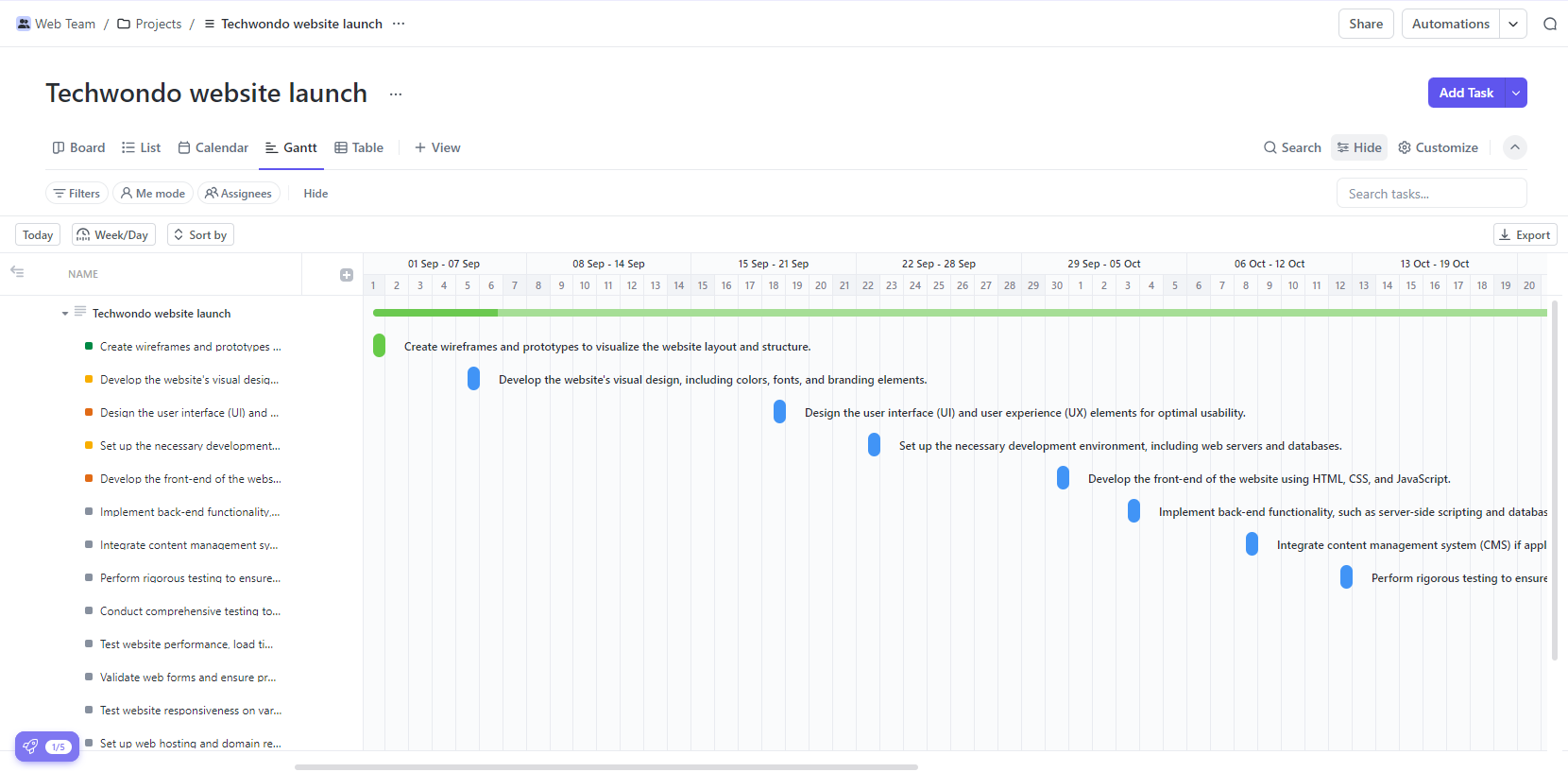
Viewing the Gantt chart on ClickUp. Source: Tech.co testing
ClickUp pricing
Free Forever: $0
This is one of the most fully-featured free plans currently available in the project management world, with 24/7 customer support, a full suite of task management and workflow creation tools, and various collaboration features to maintain team cohesion.
Unlimited access: $7 per user, per month
This is ClickUp’s first plan without any usage limitations on things like milestones and resource management. Gantt chart limitations are also removed.
Business: $12 per user, per month
The Business plan has a number of additional features that aren’t available on the Unlimited Plan, including Advanced Automations, Advanced Dashboard Features and time tracking, granular time estimates, workload management, timelines and mind maps.
Enterprise: custom pricing
This plan will be best suited to large businesses, and doesn’t have many extra features other than onboarding assistance – but if your business is big and requires a plan to match that, this is the package we’d recommend.
Teamwork
Gantt chart on Free Plan? Yes
Auto-populates Gantt Chart? Yes

Pros
- Lots of collaboration tools
- Kanban-style boards and Gantt charts available
- Affordable pricing and solid free option
- Great security options
Cons
- Limited built-in integrations
- Data visualization isn't the easiest
- Free plan available

- Deliver: $10.99/user/month

- Grow: $19.99/user/month

Teamwork overview
Teamwork is actually one of the best task management platforms, and is built for the close monitoring of project progress – it has a Gantt chart view as well as a wide variety of other preset charts you’ll find incredibly useful, including project health and workload planning charts.
Teamwork also has excellent collaboration features, but one thing you should bear in mind is that it isn’t very good for compiling post-project feedback. If the post-project phase is a crucial part of your overall project, you may want to have a peruse of the other providers on this list.
For businesses where interdisciplinary collaboration is baked into their everyday, Teamwork should be one of the first names on your list. For instance, if you needed to collate engineering teams, products teams, marketing teams, and sales teams, to track progress as you brought a product to market, Teamwork is a great place to start.
Teamwork Gantt charts
Teamwork, like ClickUp, has Gantt charts available – but unlike ClickUp, there isn’t any limit on the number of times you can ‘use’ the Gantt chart. It’s a super simple Gantt chart to use, and as long as you’ve already inputted your tasks into Teamwork somewhere, then the Gantt chart will auto-populate itself with those tasks.
Teamwork’s Gantt charts are a little less busy than the other providers on this list – as you’ll see when you go through the images for each provider, this is one of the less cluttered views you’ll have. If you find it easier to digest the information about how your project is progressing presented clearly, then Teamwork’s Gantt chart won’t disappoint.
Why we recommend Teamwork
Another favorite of ours here at Tech.co HQ, Teamwork is great for data visualization, collaborating, and security. Like its predecessor, it isn’t overly blessed with third-party integration options, but that’s another consequence of having a lot of in-built features at users’ disposal.
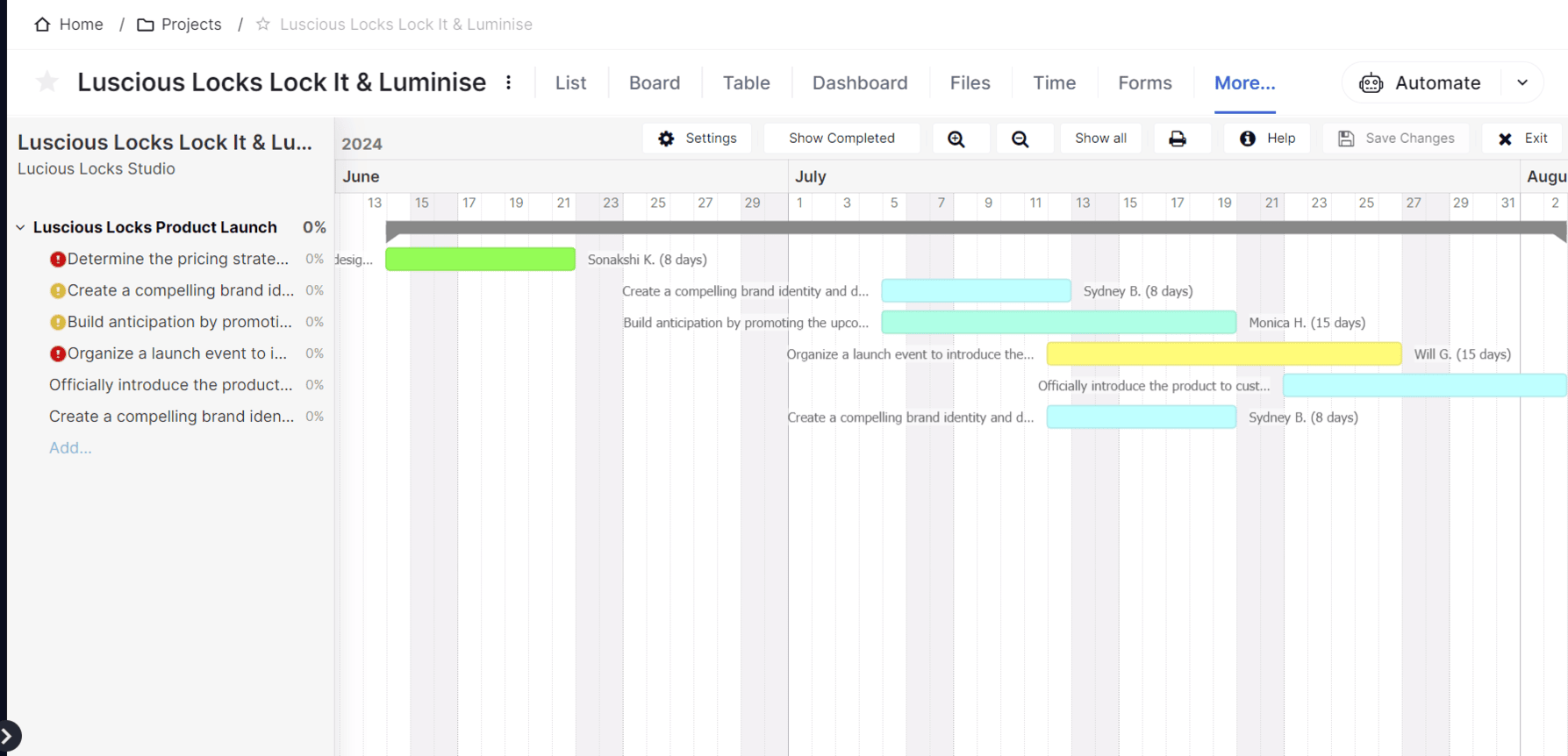
Viewing the Teamwork Gantt chart in action. Source: Tech.co testing
Teamwork pricing
Free: $0
Although Teamwork has a free plan, it’s got a maximum project limit of just two, a user limit of five, and a storage capacity of just 100MB. However, if you’re only completing one project with a small team – and you don’t need access to things like a team messenger app and billing & invoicing features, it represents a strong option.
Deliver: $10.99 per user, per month
This plan ramps up storage to 100 GB, and you can make 300 projects with an unlimited amount of users. This is the first plan where you’ll be able to integrate with business communication platforms like Slack and MS teams, so this will be ideal for small-to-medium-sized businesses that would find the free package too small.
Grow: $19.99 per user, per month
This is the fully-featured Teamwork package, which has an impressive suite of user-centric features that other plans don’t have such as form builders, CRM functionality, and burndown charts (which is useful if your team uses a Scrum Framework.
Scale: $54 per user, per month
This package is only really suitable for very large businesses and is the first plan with unlimited storage (although you’re unlikely to need this unless you’ve got hundreds of people working in the same software simultaneously and storing documents in it.
Enterprise: custom pricing
The last Teamwork tier is geared towards massive enterprises, and features premium consulting and supporting services, advanced security, SSO, and dedicated infrastructure. It has custom pricing, so you’ll have to get in touch with Teamwork to find out more.
Zoho Projects
Gantt chart on Free Plan? Yes
Auto-populates Gantt Chart? Yes

Pros
- Free trial
- Paid plans from just $4 per user, per month
- Team instant messenger for collaboration
- Gantt chart, Kanban board, calendar and task dependencies on all plans
Cons
- Free plan has no preset or custom project templates
- Teams of more than 3 will have to pay
- Guest access exclusive to high tiers and costs extra
Zoho Projects overview
Like ClickUp, Zoho Projects has a very popular free plan that actually includes a surprising number of features considering it won’t cost you a cent to install.
One of Zoho’s greatest strengths is its integrations – if you’re planning on using or are currently using CRM software during your project, Zoho is a fantastic choice thanks to compatibility with Hubspot, Sugar, and Pipedrive, and of course comms apps Slack and Microsoft Teams. There’s also Zoho’s suite of other business products (Zoho CRM, Zoho Forms, etc.)
In this respect, Zoho is a great solution for scale-up businesses that already have most of their tech and processes entrenched in their day-to-day. You can easily integrate with a number of different platforms, without having to upskill your employees on new ones.
Zoho also has the advantage of being one of the best providers we tested when it comes to value for money – Zoho’s first paid plan, the Premium plan, is just $4/per user per month if you pay annually – that’s less than monday.com, ClickUp and Teamwork’s cheapest paid plans. However, it doesn’t have the best customer support, with no live chat or support available on any plans.
Zoho Projects Gantt charts
Zoho Projects has an easy-to-use Gantt chart. Aesthetically, Zoho does go for a slightly less formal, more rounded design, which will be more appealing to some people than the straight lines of Teamwork and ClickUp but less appealing to others – it really is just a matter of opinion.
In terms of how it functions, Zoho’s Gantt Chart auto-populates with all information you’ve already inputted, much like the others on this list.
It’s one of the providers featured in this article that lets you draw your own task dependencies on the Gantt Chart, which will help you understand your project’s critical path and make informed decisions on what you should and shouldn’t prioritize.
Why we recommend Zoho Projects
Zoho Projects is a great option for businesses that don’t want to break the bank. It has a very decent free plan, and its paid plans start at a very respectable $4 per user, per month. With a wealth of integration options, it can be scaled up to your liking.
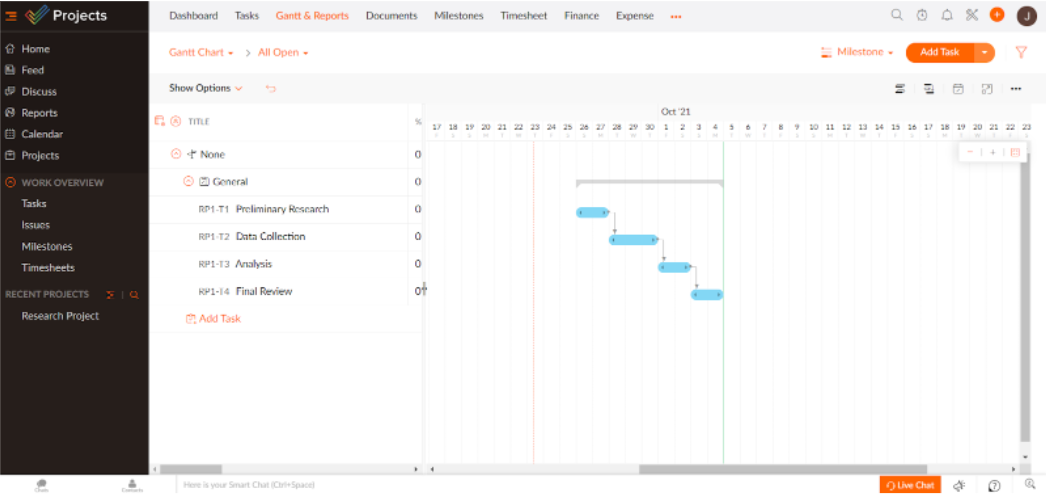
Our senior researcher, James Macey, testing out the Zoho Projects Gantt chart. Source: Tech.co testing
Zoho Projects pricing
If you’re a fan of simple pricing structures, Zoho Projects is the provider for you. Remember, compared to some of the other vendors on this list, Zoho Projects is incredible value for money.
Free: $0
Zoho Projects has a great free plan, with a large range of task management features and a great selection of collaboration tools. The only catch is there’s a three-project limit and a user limit of five, so it’s not suitable for anything bigger than a small team- and you can’t ad guests either.
Premium: $4 per user, per month
This plan offers unlimited projects, which will be fine for a significant proportion of teams, and has important features exempt from the free plan like budget management tools, sub-tasks, and guest access, as well as time tracking.
Enterprise: $9 per user, per month
This plan has no user limit, 20GB more storage than Zoho’s Premium plan, and will also allow you to create Custom Fields, which are handy when you want to add something to your project but can’t find a specific function for it.
Jira
Gantt chart on Free Plan? Yes (but only milestones, not tasks)
Auto-populates Gantt Chart? Yes

Pros
- Single sign-on available on all plans
- Excellent value for money
- Custom automation available on free plan
Cons
- Lots of tech/dev jargon
- Integrations can be confusing
- Not the best for collaborating
- Free plan available

- Standard: $9.05/user/month

- Premium: $18.30/user/month

- Enterprise: Custom pricing

Jira overview
Jira is another great option if you want to make Gantt charts for free – however, it does much more than that. One of Jira’s strengths, for instance, is its data visualization tools – which are all available on all of Jira’s plans. That means you’ll have both preset & custom charts at your disposal without paying anything, as well as a number of widgets.
You can make comments on individual tasks within Jira, but it doesn’t have much more than that in terms of collaboration features – so it’s a good thing it integrates with apps like Slack and Microsoft Teams.
Although Jira has one of the cleaner user interfaces in the project management world, you can sometimes get lost in its menus, and you can end up spending quite a lot of time menu-diving that could be spent elsewhere. But all things considered, it’s an excellent piece of software that does a bit of everything.
Jira is a favorite of tech and engineering teams everywhere. It integrates with key tools throughout the so-called “DevOps” cycle – the collaboration of IT and software development teams – such as Bitbucket, Gitlab, and more.
Jira Gantt charts
Rather than calling it a Gantt chart, Jira provides a ‘Roadmap’ view which enables you to view tasks in an effectively identical manner. However, the only downside – if you’re looking for a granular map of project progress, that is – is that only milestones (Jira calls ‘Epics’) show up in the Roadmap/Gantt chart-like view.
It’s good to know that Jira’s Free and Standard plans only allow you to create these roadmaps for individual teams whilst the pricier plans will let you create them for multiple teams. So, the more complex/multi-faceted your project – and the more teams you have working on it – the more likely it is that you’ll need a more costly plan.
Why we recommend Jira
Jira is very generous with its data visualization tools, which are available on all of its plans, including its free plan. It integrates with popular messaging apps, as well as some of the software development platforms that we’ve mentioned above.
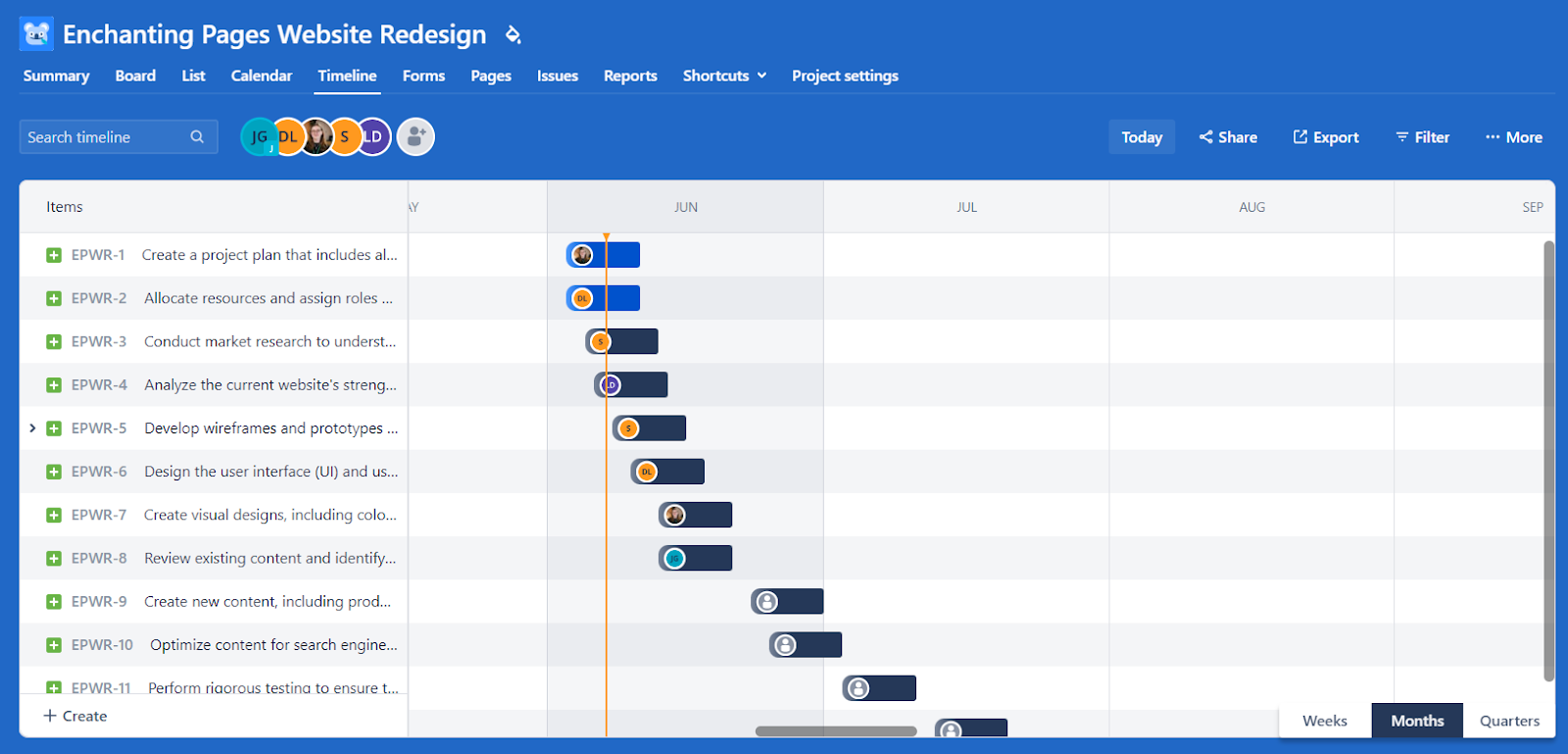
In Jira, a Gantt chart is known as a “Roadmap,” in which “Epics” can be tracked. Source: Tech.co testing
Jira pricing
Free version: $0
For free, you get a pretty decent package from Jira. There’s a whole host of data visualization tools, and workflow creation features including custom automations – which aren’t offered for free by every provider. Jira will restrict you to 2GB of storage but there are no limits on users or projects like there are in Zoho Projects and Teamwork.
Standard: $8.60 per user, per month
You don’t get many more features that aren’t available in the free version on Jira’s Standard plan. However, your storage capacity is ramped up to 250GB and there are more automations are allowed, so it’s a much better choice if you’ve got a data-heavy project.
Premium: $17 per user, per month
Jira’s premium plan has all of the Standard plan and Free plan features but also has some handy extras like resource management tools. You’ll also get access to Atlassian Intelligence, which allows you to generate, summarize, and search for content.
monday.com
Gantt chart on Free Plan? No
Auto-populates Gantt Chart? Yes

Pros
- Highly customizable platform
- Custom fields feature available on all plans (including the free plan)
- Rule-based automation can be used to complete simple tasks, like archiving items
Cons
- Free plan has 2-person user limit
- Limited third party integrations
- Higher tiers required for basic features
- Free plan available

- Basic: $9/user/month

- Standard: $12/user/month

- Pro: $19/user/month

monday.com overview
monday.com is the best project management software we’ve tested here at Tech.co – it has absolutely everything you need to run a successful project from multiple locations.
The provider excels when it comes to customization and will let you exert a lot of control over the planning of your projects.
“Items are easy to create, and being able to move the order of tasks is very useful. The option to create subitems is also very handy for organization and keeping track of tasks with different priorities” – Jess, a campaigns executive who uses monday.com.
There are lots of team collaboration features, including a dedicated resource management chart that lets you track every team member’s workload, and an inbox for project communications. This feature is particularly useful for managers with several employees reporting into them, as it can give you oversight of who is overburdened and who might have more capacity.
monday.com is supposed to be a one-stop-shop for project management from the conception stage of your project right the way to the post-project feedback stage, which monday.com can help you with thanks to features like a form builder and guest access.
monday.com Gantt charts
monday.com doesn’t have a very expansive free plan (although it has a 14-day free trial that will let you take one of its fully-featured plans out for a spin) so you won’t be able to make a Gantt chart for free. However, if you do choose monday.com, you’ll have one of the slickest-looking Gantt charts in the project management game.
Gantt charts are really easy to create with monday.com because all you need to do is add the Gantt chart view to your project (which only takes a couple of clicks) and all of your tasks will appear on a Gantt chart without you having to type them all in and organize them.
Why we recommend monday.com
Simply, monday.com is our top choice of project management software. It’s a great all-rounder – really easy to use, good value, good free plan, feature-rich, and stacked with integrations. Like everything on monday.com, building a Gantt chart is breeze. After a couple of clicks, all of your desired data will auto-populate.
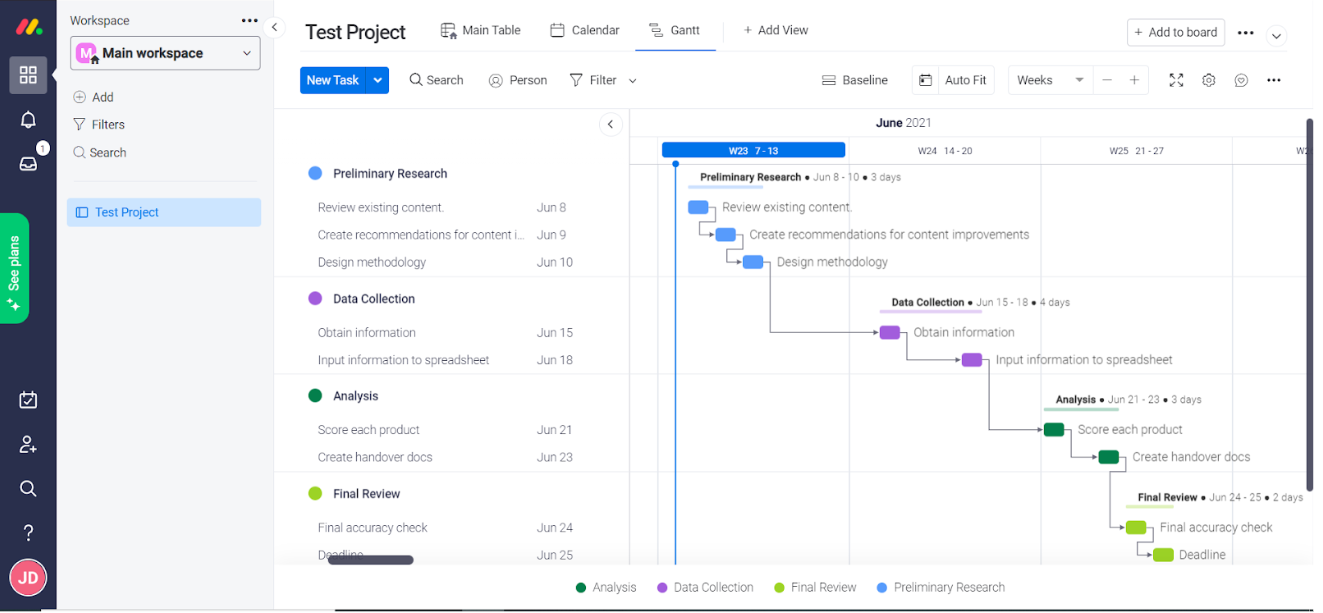
Viewing a Gantt chart in monday.com. Source: Tech.co testing
monday.com pricing
monday.com has four pricing plans available, starting with a free plan – although you won’t be able to access the Gantt chart view. The pricing plans monday.com offers are:
Free plan: $0
This is a limited free plan that only allows for 2 ‘seats’ (users) so isn’t suitable for projects being carried out by larger teams. You’ll still get a lot of features (Kanban boards, custom fields, dashboards, widget builders, etc.) but there’s no onboarding assistance or phone-based customer support and you won’t be able to access resource management tools, but it’s still a decent free plan.
Basic: $9 per user, per month
Monday’s Basic plan offers many of the same features as the free plan, but you’ll be able to orchestrate projects with an unlimited amount of users, which makes the collaboration tools monday.com provides (task comments, online whiteboard, document editing) all the more useful. Still no Gantt charts, though.
Standard: $12 per user, per month
This plan includes everything available in the Basic Plan, but some handy extra features like Guest Access, the capacity to incorporate Comms and CRM integrations, and custom automations that’ll improve project efficiency. This is the first monday.com plan which will let you access Gantt charts, so if that’s what you’re here for, then this is the plan to focus on.
Pro: $19 per user, per month
This package consists of the Standard plan features plus a few handy extras like private boards, time tracking, and the ability to create a dashboard that combines 20 separate boards.
Enterprise: bespoke pricing
You’ll have to contact monday.com directly if you feel the Enterprise package is the only one that will suit your business. But, you’ll have more storage, more actions, and more integrations available than any other plan, as well as onboarding assistance.
Gantt Chart Software vs Project Management Software
There are some places to get Gantt Chart software for free – a cursory Google search will show you that there are several options out there. However, there are actually very few reasons to opt for dedicated Gantt Chart software over a broader project management software package, and here’s why:
There are plenty of free PM software packages
Many of the software packages mentioned in this article have free versions that let you create and use Gantt charts. This means can get your hands on the best Gantt charts out there without paying a single cent.
Additional project management features
If you need Gantt chart for your project, we have a funny feeling you may find some other project management tools handy too. With project management software like ClickUp, you’ll have Gantt charts and much, much more at your fingertips – a luxury you won’t have with basic Gantt chart software.
Customer support
Generally, the customer support you’ll receive from a multinational project management software company will be markedly better than what you’ll receive from a free Gantt chart provider website.
How Can a Gantt Chart Help my Business?
Gantt charts are an incredibly useful visual tool for project managers working on all sorts of projects. It’s the sort of tool that busy project managers will find beneficial because they won’t have to spend precious time reiterating project plans or how much progress has been made.
If used within project management software, for instance, it can provide all team members with the most up-to-date state of affairs. Indeed, Gantt Charts will help your business in a number of ways, including:
Make workflows more efficient
What’s more time-consuming than employees who don’t know what’s going on, and need to have every little aspect of a given project re-explained to them? Very little, in business terms. Gantt charts will save you time through the creation of a clear project roadmap everyone can look at.
Accurate forecasting
There’s nothing more demoralizing than being set an unrealistic deadline – this can happen if you set one way too soon, or too far in the future. Gantt charts will aid with the creation of realistic goals and deadlines, simply because you’ll have all the information laid out in front of you.
Methodology: How We Test Gantt Chart Software
At Tech.co we don’t write about products and services without conducting thorough research, and hands-on testing where applicable. While this process can be time-consuming, it’s time well spent if it means we’re providing better, more useful information for your business.
When it comes to project management software, we test out each program first-hand, guided by an in-house research framework consisting of six core assessment areas that break down into a range of smaller subcategories. This framework is based on the factors companies and project managers have told us are important to their everyday usage. The six criteria are:
- Ease of use: After getting five to six participants to test each project management software for an hour, we assessed how easy it was to set up a project with the platforms, how clear their interfaces were, and how easy they were to navigate.
- Pricing: We look at all plan costs. Providers offering lots of features for lower costs will have better pricing scores than those that lock them away on higher-tier plans.
- Customer support: We assess the ways you can contact your project management software provider if something goes wrong. Providers offering 24/7 live support, as well as phone-based support and onboarding assistance, get the best scores.
- Security: For this area, we assess the security options offered by each provider. This includes user-level security features like two-factor authentication, as well as more administrative security measures like user permissions and IP restrictions.
- Integrations: We assess the quantity — and the quality — of the applications each project management software provider integrates with.
- Functionality: This part of our research involves assessing the full feature set that each product provides. We look at four function-based sub-categories as part of this, including task management, project and workflow creation, data visualization, and collaboration.
It’s important to note that not all of these criteria hold equal weight in our testing methodology. This is best practice and based on what businesses have told us is essential, compared with what’s simply “nice to have”.
Because of their central importance to project management, how easy each tool is to use, how much it costs, features for project and workflow creation, and task management had more of an impact overall than other criteria.
Verdict: ClickUp is the Best Gantt Chart Software
Although it has faced stiff competition from the likes of Teamwork, ClickUp is the best Gantt chart software out there – largely because you don’t have to pay anything to use it and can gain access to loads of useful project management tools at the same time.
However, if you’d like an all-encompassing project management solution that will give you Gantt charts and much more – and you’re prepared to pay for quality – monday.com is the way to go. You can get yourself Gantt charts for less with ClickUp, of course, because monday.com doesn’t have a free plan, but it’s the best one overall.
If you click on, sign up to a service through, or make a purchase through the links on our site, or use our quotes tool to receive custom pricing for your business needs, we may earn a referral fee from the supplier(s) of the technology you’re interested in. This helps Tech.co to provide free information and reviews, and carries no additional cost to you. Most importantly, it doesn’t affect our editorial impartiality. Ratings and rankings on Tech.co cannot be bought. Our reviews are based on objective research analysis. Rare exceptions to this will be marked clearly as a ‘sponsored’ table column, or explained by a full advertising disclosure on the page, in place of this one. Click to return to top of page










